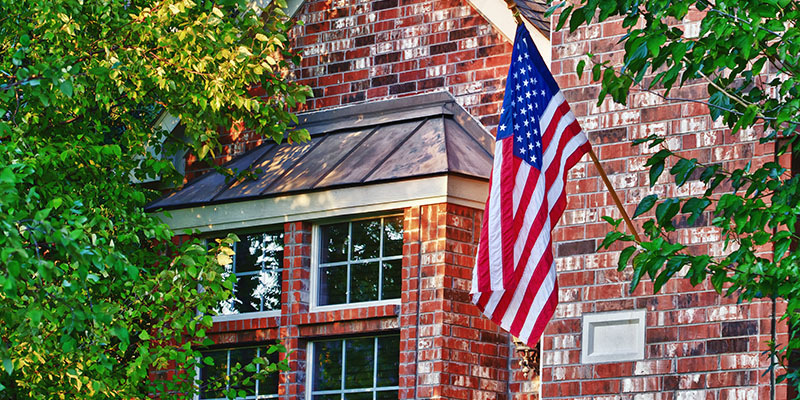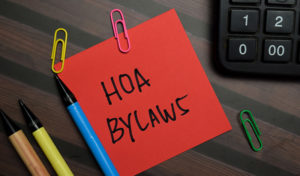HOA Political Flags: Should They Be Allowed Or Not?

Members of a homeowners association must follow all the rules and regulations set forth by their governing body. The main purpose of these restrictions is to protect property values and the interests of the entire community. However, is it legal for the HOA to regulate or prohibit flags? Here’s what you need to know about restrictions on HOA political flags.
Browse By Category
Sign up for Our Newsletter
Members of a homeowners association must follow all the rules and regulations set forth by their governing body. The main purpose of these restrictions is to protect property values and the interests of the entire community. However, is it legal for the HOA to regulate or prohibit flags? Here’s what you need to know about restrictions on HOA political flags.
HOA Political Flags: Can HOA Prohibit Them in Your Community?
Homeowners associations can place restrictions on signs and banners that residents display. But, is a flag considered a sign? The answer is not quite as simple. Instead of asking “Is a flag a sign,” you should be asking “What kind of flags are allowed?” You see, it really depends on the type of flag it is.
An HOA cannot prohibit its homeowners from displaying the U.S. flag on their property. Based on the Freedom to Display the American Flag Act of 2005, it is illegal for homeowners, condominium, or co-op associations to enforce any policy that restricts or prevents a member’s right to display the U.S. flag on their residential property.
The federal law also includes two considerations. First, the flag must be displayed or used properly in accordance with federal law. Second, the association can place “reasonable restrictions on the time, place, or manner of displaying the flag” to protect its substantial interests.
Can an HOA Restrict Flags?
While associations cannot prevent homeowners from displaying the U.S. flag on their properties, they can still implement specific HOA rules regarding flags.
For instance, the HOA may send a notice to homeowners who are not displaying their flags correctly.
According to the U.S. Flag Code:
- You can only display the flag from sunrise to sunset unless the flag is illuminated at night.
- You must take down the flag during rain, snow, or storms unless it is an all-weather flag.
- The flag must not touch the ground or have anything beneath it.
- The flag should not be displayed in a way that would make it damaged or soiled.
- You cannot place letters, symbols, insignia, or designs on the flag.
- Destroy all worn-out flags in a dignified way (i.e. burning).
HOA flag rules can also dictate when, where, or how you can display the flag on your property. In many communities, there are also homeowners association flagpole guidelines in place. For instance, the HOA may regulate the size and location of flagpoles on a homeowner’s property.
How Should the HOA Deal with Flag Displays?
The American flag — and all the values it represents — means a lot to many homeowners. As such, HOA flag restrictions can be a very contentious issue. It can lead to tension, fights, or even costly litigation. In order to maintain peace within the community, here are some helpful tips for dealing with flag displays.
1. Make Sure HOA Flag Rules Are in the Governing Documents
The association should only enforce flag rules that are stated in the governing documents. Otherwise, the HOA board has no authority to restrict the use or display of any type of flag. If you want to enforce certain flag rules, make sure to amend your governing documents first.
Given how important flags are to some homeowners, the association should also enforce the most reasonable restrictions it can. Do not make your homeowners’ lives harder with unreasonable restrictions. This way, the HOA can look after the interests of both the community at large and individual homeowners.
2. Check State and Local Laws
Apart from federal mandates like the Freedom to Display the American Flag Act of 2005 and the U.S. Flag Code, some states have additional laws for displaying flags and installing flagpoles. For example, in states like Florida, Washington, and Colorado, the law states that flagpoles should be not more than 20 feet high, should not obstruct sightlines at intersections, and should not be installed within or upon an easement.
3. Establish Clear Guidelines for Installing Flagpoles
The HOA should have clear guidelines on how homeowners can display their flags correctly. Homeowners should know the appropriate size and type for flags and what is considered a reasonable size and height for a flagpole.
Also, the HOA should inform homeowners on how to proceed with installing their flagpoles. For instance, they must first file an application with the architectural review committee. This is to ensure that flagpoles are not installed under water pipes or other important components and that the design does not clash with the overall aesthetics of the community.
4. Avoid Selective Enforcement of HOA Flag Rules
If the community allows other types of flags, make sure to enforce the rules fairly and uniformly. You cannot allow homeowners to display holiday flags and at the same time, send notices of removal to homeowners who display the rainbow flag. The latter may be considered as discrimination under the Fair Housing Act, which could lead to potential litigation.
What About HOA Political Flags and Banners?

Unlike the American flag, the HOA has the authority to restrict homeowners from displaying political signs and banners. But, is a political flag considered a sign? Political signs can take many forms, and that does include flags.
Homeowners who want to display political materials will often cite the First Amendment. This prevents federal, state, and local governments from stifling one’s freedom of speech.
However, an association is not a government entity. The First Amendment does not influence HOA governance. Also, keep in mind that everyone who joins an HOA signs a contract. If the governing documents prohibit the display of political paraphernalia (and state law allows such prohibitions), then homeowners must abide by these restrictions.
If the HOA wants to accommodate the political beliefs and affiliations of homeowners, the board can implement specific rules when it comes to displaying political signs. Here are some examples.
- Political signs can only be displayed 45 days prior to an election. They must be removed a week after the election.
- Political signs must remain respectful. They cannot contain any profanity or foul messages.
- Homeowners can only post x number of signs on their property.
- Political signs must not create obstructions and other safety hazards.
- Political signs should be within the homeowner’s property limits.
As with other HOA restrictions, make sure that these rules are clearly outlined in the governing documents. The board should implement these rules consistently and uniformly to avoid problems with homeowners.
Generally speaking, though, it is best not to prohibit HOA political flags and signs altogether. This will only create problems down the road for the association. The best course of action is to allow the display of such political items during the election season, coupled with a few other rules as explained above.
HOA and Political Flags: State Exceptions and Court Rulings
There are some exceptions to the rule, though. Some state laws prohibit associations from banning the use of HOA political signs such as flags and banners. For instance, in California, Civil Code Section 4710 states that HOAs cannot prohibit homeowners from displaying noncommercial signs, banners, or flags on their own property. That includes political flags and signs.
They can, however, restrict such paraphernalia in common areas. In condominiums, common areas extend to the windows, walls, and doors. Associations can also implement political yard signs rules concerning the size and materials of these signs as well as the number of signs.
It is also worth checking the highest court rulings within your state. Keep in mind that a majority of states are mum about this issue, but court rulings could give you an idea about where your state courts stand on the matter. Such decisions could also affect similar issues in the future.
What About Other Types of Flags?
The American flag and political flags are common points of contention when it comes to displays. But, are there any exceptions when it comes to other flag types?
Although homeowners associations may have restrictions on flag or sign displays, such restrictions usually do have exceptions. This includes signs concerning security, real estate, or the developer. An example would “For Sale” signs. There are also other signs that may be approved by the board.
You might think such exceptions will not pose problems for your HOA. But, liability-wise, they can open you up to accusations of arbitrary or selective enforcement. If your HOA completely prohibits political signs but allows other signs, the validity of the enforcement may be challenged. The same goes for HOAs that allow holiday decorations but universally forbid signs.
If your association believes that your current rules on flags and signs are inconsistent or lacking, then it is time to amend your governing documents. The amendment process can vary from HOA to HOA and state to state. But, for most associations, it will require a majority vote from the membership. Make sure to consult with an HOA attorney if you intend to revise your governing documents.
Homeowner Recourse on Political Flags HOA Enforcement
Some homeowners may feel that their HOA is enforcing flag and sign rules in a selective, arbitrary, or discriminatory manner. In this case, they have a few options available.
First, homeowners can bring the matter to the board’s attention. Sometimes, the board is just unaware that it is enforcing these rules in such an inconsistent way. Simply raising the issue might resolve it. Of course, that does not mean the board is free from any wrongdoing. Board members have a fiduciary responsibility to enforce rules in a uniform manner.
Second, if the issue leads to a dispute, the homeowner may use alternative dispute resolution. This usually involves either mediation or arbitration with the board.
If worse comes to worst, homeowners can choose to sue the association. This will require homeowners to present proof that discriminatory, selective, or arbitrary enforcement took place, which is typically hard to do. Additionally, homeowners will have to hire an attorney, and legal fees can be quite expensive.
Harmoniously Working With and Around Flag Restrictions

The HOA board has great power but they must exercise this power responsibly. They should ensure that the entire community abides by federal, state, and local laws, as well as the governing documents. When it comes to HOA political flags and beyond, associations must be able to find a harmonious balance between following the law, protecting the interests of the community, and providing homeowners with a means to express themselves.
Navigating federal and state laws can come as a challenge without professional guidance. Start looking for the best HOA management company near you using our online directory.
RELATED ARTICLES:
- 6 Tips On How Can HOA Enforce Rules And Regulations
- The Ins And Outs Of Covenant Enforcement For Your HOA
- What Are HOA Disputes? How To Practice Dispute Resolution?
Trending Now
Related Article
Sign up for Our Monthly Newsletter
Sign up below for monthly updates on all HOA Resource

















